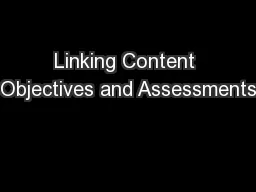

to Increase Student Learning Adriana Brandt Dee Murray Angie Child Session Objectives I can explain why establishing learning objectives for each class session is important and why I should share these with objectives with my students ID: 777176
Download The PPT/PDF document "Linking Content Objectives and Assessmen..." is the property of its rightful owner. Permission is granted to download and print the materials on this web site for personal, non-commercial use only, and to display it on your personal computer provided you do not modify the materials and that you retain all copyright notices contained in the materials. By downloading content from our website, you accept the terms of this agreement.
Slide1
Linking Content Objectives and Assessments to Increase Student Learning
Adriana
Brandt
Dee Murray
Angie
Child
Slide2Session Objectives
I can explain why establishing learning objectives for each class session is important, and why I should share these with objectives with my students.
I can identify and describe appropriate assessment strategies for determining if students have met the objectives I’ve established.
I can develop a sample objective for a class session in my discipline, and create an assessment that tells me whether or not students reached learning at the desired level.
Slide3Why do daily objectives matter? Why should we share them with
learners
?
Clear objectives:
Make learning transparent to the learner
Focus learning experiences on the knowledge and skills you want learners to learn
Facilitate metacognition for both instructor and learner
Give focus to feedback and assessment
Slide4Agenda or objectives?
p. 35, even problems
Lab #28
Chapter 4
Film + discussion
Quiz
Write and balance chemical equations.
Explain the significance of the protagonist’s point of view, and compare this element to other works s/he has read.
Apply cinematographic vocabulary to the analysis of a short film.
Slide5How SMART are your objectives
?
S
:
specific
M
:
measurable
A
:
attainable
R
:
realistic
,
relevant
(to you
and
the learner)
T
:
timely
, trackable
Slide6How do I write an objective?
Objectives are for the learner. They should be
concise
and
written in language that the learner can understand
.
Objectives should use verbs that promote
active engagement
in the content and in the class, and that are
measurable
.
Slide7Say more about those verbs…
Strive for
active verbs
in objectives
(e.g. discuss, apply, explain, create, analyze, justify, compare and contrast)
Avoid
passive verbs
in objectives
(e.g. know, understand, appreciate, learn)
Slide8What is an example of an appropriate university course objective?
Students will explain the rationale for historical
thinking
,
and apply the essential elements involved in historical thinking.
Slide9Your turn!
Think about a class session you’ve recently taught, or are about to teach.
Develop one or two sample objectives that align with that class session.
Once you’ve written your objective, find a partner from another discipline to review your objective and provide feedback.
Slide10Pause and (self-)assess
Assess/evaluate your written objective. Is
it
SMART?
S
:
specific
M
: measurable
A
:
attainable
R
:
realistic, relevant
(to you
and
the learner)
T
:
timely, trackable
Slide11Aligning Assessments to our Objectives
Now that we have clear and measurable objectives written…
Assessment
Objective
Slide12Why align a
ssessments
to
o
bjectives
?
Reveal how well students have learned what we want them to learn (content validity).
Accurately measure student success of the learning outcomes.
Gain useful assessment data to make generalizations about both our students and our teaching.
Slide13Assessments should be learning f
ocused
Ask yourself
:
What kinds of tasks (assessments) will reveal whether students have achieved the learning objectives I have identified?
Slide14Can I see an example?
Lesson Objective
: Students will explain the rationale for historical
thinking
,
and apply the essential elements involved in historical thinking.
Assessment
: Students will exhibit their understanding of each of the 5 elements of historical thinking by providing examples to a small group of peers.
Slide15Your turn!
Using the objective you wrote with Dee, write an assessment that aligns with the learning and will tell you whether or not the learning has taken place.
Once you’ve written your assessment, find a partner from another discipline to review your assessment and provide feedback.
Slide16How did we do?
I can explain why establishing learning objectives for each class session is important, and why I should share these with objectives with my students.
I can identify and describe appropriate assessment strategies for determining if students have met the objectives I’ve established.
I can develop a sample objective for a class session in my discipline, and create an assessment that tells me whether or not students reached learning at the desired level.